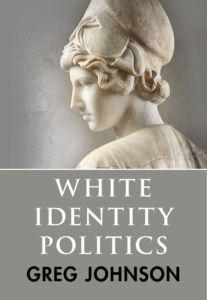A Black Nationalist on the Jewish Question
Ayo H. Kimathi
Jews are the Problem, second edition
Crestview, Fla.: Money Tree Publishing, 2023
Ayo H. Kimathi received considerable scorn in the mainstream media for his Black Nationalist racial activism while working as a contractor for the Department of Homeland Security (DHS) in 2013. At the time, he was making many anti-white statements that would have been tolerated during the Summer of Floyd in 2020, but weren’t tolerated in 2013. Kimathi lost his job at the DHS, but his story doesn’t end there. Kimathi kept on digging after 2013 and became aware of the Jewish Question as a result.
Kimathi published a book this year called Jews are the Problem. The book is aimed at an “Afrikan” reader (his term), but white advocates should be aware of it and should make sure that the book becomes widely known. Jews are the Problem is not written at the high academic level of Professor Kevin B. MacDonald’s trilogy on Jews, so it is a quick read. The book’s conclusions are excellently laid out in such a way that the reader can draw many follow-on insights from them.
Afrikans, Anglo-Saxons, & Jews
Kimathi describes the racial tensions in the United States as running between three groups: Afrikans, Anglo–Saxons, and Jews. He points out that tensions between Afrikans and Anglo–Saxons in the form of the police arresting Afrikans at high rates and so on is a problem, but a minor problem compared to Jewish manipulation of the national narrative, economy, and government. Without the Jews, relations between Anglo–Saxons and Afrikans would not be as acrimonious as they are. The book also contains QR codes the reader can scan to dive into the extensive source materials behind the points Kimathi is making.
Anglo Christian–Zionists in the US who so uncritically back Israel and global Jewry are wrong when they view the Jewish religion as the same faith as that of the figures in the Old Testament. The Jews occupy a unique place, being both a religious community and an ethnic group, but their religion is one that worships their ethnicity rather than focusing on higher and universal spiritual morality. Judaism’s holy scripture is the Babylonian Talmud, which has a dual morality: one for Jews and the other for non-Jews. “This ‘holy’ book of the Jews,” writes Kimathi “provides acceptance of rape, pedophilia, homosexuality, murder of non-Jews, theft from non-Jews, and promises the Jews they will one day rule over all the people of the Earth. It also instructs Jews to never view non-Jews as people” (p. 6).
The Babylonian Talmud is expressed in real political and social terms through the Protocols of the Elders of Zion. The Protocols were probably written by the Russian secret police in Tsarist times, so the case is often made that they are a “forgery.” But they nevertheless accurately show how the Organized Jewish Community manipulates their host societies. Kimathi sums the situation up succinctly, writing:
The history of Europe is of Whites [sic] struggling to survive the parasitic invasion and overthrow of their communities, regions, or nations by subversive money-grabbing Jews. The history is 100% clear and has been well documented. This Jewish seizure of the wealth and resources of Europeans reads like a bad episode of Pinky and the Brain. Go! Some White [sic] country is doing relatively well. The Jews, Ashkenazim or Sephardim, find a way to get in. They become merchants. They create debt. They become rich while the people become poor. They begin to sex-traffic women and children. They popularize some form of pornography. They turn the country into a blazing immoral inferno of filth and indecency. Some prophet figures out who did it and how. They go to the people and identify the problem. The people all compare their debts, losses, and foreclosures and realize they’ve been had. Then either two things happen:
1. The Jews kill the prophet and the people become outraged.
2. The people organize to get the Jews out of town. (p. 22)
Jews are also instrumental in pushing malign social contagions which they themselves know are maladaptive, but that harm their gentile hosts. One such Jew is Yuval Noah Harari, who is a homophile, transhumanist Jew married to a man. Harari is pushing new, transhumanist technologies which will clearly end badly.
Jews were also heavily involved in the slave trade. While Anglo-Saxons admit they were involved in the slave trade, Jews hide and deny this. Dr. Tony Martin, who wrote about this topic, had his reputation smeared by the organized Jewish community. Anglo-Saxons also worked to end the slave trade. The British ended slavery in the West Indies by buying their way out of the scourge. America ended it through a disastrous Civil War. Even many Confederates were not sympathetic to slavery, maintaining that the institution of slavery was not their primary war aim. Judge Roger Taney, who was Chief Justice of the Supreme Court from 1836 until 1864, ruled in favor of slavery, despite the fact that he personally disliked slavery and freed his slaves.
Jews wage war by proxy. Since at least 1941, Americans end up being the proxy fighting for Israel’s interests, such as during the Iraq War.
Whenever possible, Jews put themselves on both sides of a contentious issue. This allows them to keep a particular debate within the bounds of acceptability for the organized Jewish community. Jews were on both sides of the US Civil War, for example, although they favored the Confederacy. Judah P. Benjamin, the first Jew to be elected to the US Senate who had not renounced his faith, served in three different cabinet posts in the short-lived Confederate government.
During the Civil War, the first anti-Jewish measures enacted in the US were enacted by the Union army. General Ulysses S. Grant threw the Jews out of his military district because they were buying and selling cotton on the black market and keeping the proceeds for themselves. Union policy was to use the proceeds of the cotton sales from areas that were in a state of rebellion but had been occupied to fund the war. Grant’s decree was General Orders #11, and Kimathi refers to it several times in the book. Indeed, the biggest ethnic conflict in the US is that between the Yankee Anglo-Saxon subgroup and Jews.
1913
The future President, Woodrow Wilson, grew up in Staunton, Virginia. Between his family’s house and his father’s Presbyterian church was a Jewish synagogue. This could be seen as an allegory of Wilson’s administration and the negative changes it wrought. Wilson was the first President to get the US involved militarily in the affairs of other countries, and he ultimately allowed foreign influence to become part of the American political conversation.
Woodrow Wilson became President in 1913, and “1913 was very pivotal for America” (p. 66). It was the year the Federal Reserve was founded, and also when Leo Frank, a “#metoo” sort of Jew, raped and murdered a young Southern girl named Mary Phagan. Frank blamed the murder on an Afrikan, but the Southerners on the jury didn’t buy the story. Frank was found guilty, but used his connections within the organized Jewish community to have his death sentence overturned. Frank was eventually (deservedly) lynched by Georgia’s prominent Southern citizens. The organized Jewish community responded by establishing the Anti-Defamation League, which aggressively pursues Jewish aims and defames anyone who resists them to this day.
In 1915, after America had moved on from the Civil War, Jews sponsored, promoted, and distributed D. W. Griffith’s film The Birth of a Nation, which helped to relaunch the Ku Klux Klan. While it appears to endorse the reunification of Northern and Southern Anglo-Saxons and ends with a call for the US to stay out of the ongoing First World War, it was in fact a Jewish deception operation. The film flips the Mary Phagan story on its head, having a character who is similar to her who is raped and murdered by an Afrikan (played a white actor in blackface). The reason for this was to deliberately cloud Leo Frank’s story, as well as negative Jewish influence on America in general, by shifting the blame to Afrikans. Kimathi’s interpretation of The Birth of a Nation further explains why D. W. Griffith made the film Intolerance in 1916, as it can easily be interpreted as a philo-Semitic film.

You can buy Greg Johnson’s White Identity Politics here.
During the Wilson administration, Jews in Russia overthrew the Tsar and established the Bolshevik Empire, which went on to kill, starve, and enslave Eastern Europeans on a massive scale. During this period the British likewise issued the Balfour Declaration, promising the Jews a “homeland” on Palestinian land, in the hope of using Jewish pressure to bring the US into the First World War on their side, among other things.
Jews were already heavily involved in advertising and the mainstream media in the US in 1913. In fact, they had more control over the media then than now, given that alternate points of view can be disseminated via the Internet. Not only did they blackwash the Leo Frank incident in The Birth of a Nation, but they promoted negative images of Afrikans in advertisements. Jews also promoted blackface minstrel shows. And today, advertising is now part of the war on whites. Jews further undercut Booker T. Washington’s idea of improving the Afrikans’ economic prospects through honest work by controlling the emerging labor movement and excluding Afrikans from it.
Later, in 1923, a Jewish judge, working with Jewish prosecutors and a Jewish jury, sentenced Marcus Garvey to prison. Garvey had been attempting to establish a “back to Africa” movement that was backed by Anglo-Saxons such as Earnest Sevier Cox. This was no doubt because Jews in the US felt that their interests were better served through integration of blacks into American society, given that this is guaranteed to create maximum racial friction. The Jewish-led National Association for the Advancement of Colored People, founded in 1909, has used Afrikans as a battering ram against Anglo-Saxons from the outset, which prevents the latter from effectively resisting the organized Jewish community.
Homosexuality as genocide
Kimathi views Jewish promotion of homosexuality as a way of reducing both Afrikan and Anglo-Saxon birthrates in the US. Many Afrikan celebrities who support homosexuality are promoted by them, for example. Homosexuality effeminizes Afrikan men. Kimathi is especially critical of basketball star Dwayne Wade, who is raising his son as a girl.
The film The Color Purple (1985), produced by the Jew Steven Spielberg, is an example of a Jewish metapolitical attack on the Afrikan family. It is considerably different from the book it is based on, depicting Afrikan men as abusive and encouraging lesbianism among Afrikan women.
Kimathi discusses the COVID-19 pandemic and the subsequent vaccination program. I’m old enough to remember when those who had lived through the time of polio thought vaccines were a miracle. I also once met a veteran who had been a Japanese prisoner-of-war during the Second World War who told me that those who survived the ordeal were vaccinated, while those who hadn’t been — mainly Dutch colonial troops – died. Thus, I’m not sure what to believe about the vaccines. Kimathi is opposed to them. But regardless of one’s views on vaccination in general, COVID-19 is not the Black Death and the COVID vaccines are not really “safe and effective.”
Jews are essentially Bolsheviks. The Bolsheviks’ murderous impulses weren’t a Slavic characteristic, but were the same vicious impulses that Jews have demonstrated since Joshua attacked Canaan. To take some reason examples, they turned the Black Lives Matter movement from a genuine call for reform into a polarizing movement that supported violence and disorder, and stirred up anti-white sentiments. Jews likewise encouraged Afrikans to help steal the election for Joe Biden and his mostly Jewish staff.
Kimathi writes:
With Black [sic] leaders and many Black [sic] women worldwide controlled by Bolsheviks, it is very easy to lead Black [sic] people in the wrong direction. When the “Justice for Mike Brown” movement was taken over by the Bolshevik-controlled, George Soros-funded, LBBT-promoting, Gay Lesbian Movement (formerly known as BLM), the battle was won. Billionaire Bolsheviks pay Black [sic] homophiles and lesbians to make a few television appearances at rallies and blasted it throughout their media. They paid them to fly around the country and steal the momentum of genuine movements and crush the voices of real warriors . . . By the time the Bolsheviks were finished, you had an entire movement limp, millions of dollars in donations from well-meaning people spent on mansions and other accessories for a group of obnoxious queers, and a “Black [sic] uprising” that changed focus from justice to the perpetrator into “burn it down and destroy the buildings so Bolshevik investors can return and purchase the properties at alarmingly low prices.” Many genuine activist movements start off as rebellions against abuse and turn into Bolshevik land grabs. (pp. 155-156)
Kimathi has some Afrocentrist views on ancient Egypt, but instead of promoting the idea of sub-Saharan Africans as the true Egyptians, he focuses on the spiritual aspect of the Egyptian religion and its impact on other faiths, such as Christianity. Christians have more of a debt towards the faith of Egypt than Judaism, such as in relation to forgiveness. Christian peoples can move on from the hatreds of their past, while Jews are still filled with a burning hatred towards “Amalek.”
The section on Afrocentrist ideology is the weakest part of the book, but it’s unsurprising given that its purpose is to awaken Afrikan men to the threat that Jews pose to them. Afrocentrism is a central part of Black Nationalism, and raising awareness about the Jewish Question means that its advocates must be all people to all men.
Other weak points in the book include Kimathi’s misinterpretation of General Orders #11. Kimathi says that Grant removed Jews from the US Treasury Department, and while the wording of the order implies that this what Grant did, he in fact ordered Jews out of the military district he was commanding; namely, the area of Tennessee that had been occupied by Union troops. Grant didn’t have the authority to dismiss Jews from the US Treasury Department (unfortunately). This error will be pounced on by Jewish activists should this book come to their attention.
Kimathi is also critical of the Federal Reserve, despite the fact that the idea for it came from agrarian populists such as William Jennings Bryan, who were called “anti-Semites” in their day. The problem isn’t the Federal Reserve itself, but rather Jewish control of it. Who knows what bad decisions have been made or major embezzlements have occurred when a Jew is at the helm of this institution?
Kimathi calls all Jews Bolsheviks. Not all Bolsheviks were Jews, however, even if they were disproportionately represented among them. Stalin was a Georgian, for example, and Georgians were the critical “junior partner” of the Soviet Empire. This is another thing that Jewish critics could use to dismiss the book.
The book ends with a number of ideas about how to inform people about the Jewish problem, including how Anglo-Saxons and Afrikans can come to a better arrangement. This book is an excellent primer on the Jewish Question for those Afrikans who are searching for the actual root cause of today’s problems.




